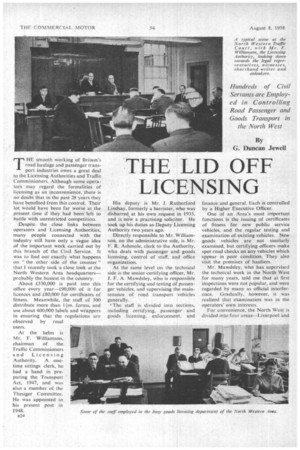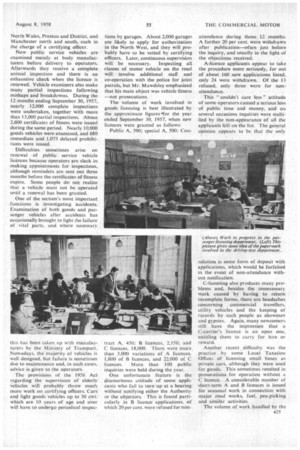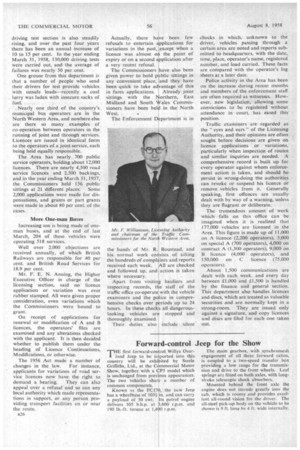THE LID OFF LICENSING
Page 58

Page 59

Page 60

If you've noticed an error in this article please click here to report it so we can fix it.
By G. Duncan Jewell
THE smooth working of Britain's road haulage and passenger transport industries owes a great deal to the Licensing Authorities and Traffic Commissioners. Although some operators may regard the formalities of licensing as an inconvenience, there is
• no doubt that in the past 28 years they have benefited from this Control. Their lot Would have been far worse at the present time if they had been left to battle with unrestricted competition.
.Despite the close links between operators and Licensing Authorities, many people connected with the industry still have only a Vague idea of the important work carried out by this branch of the Civil Service. It was to find out exactly what happens on " the other side of the counter" that 1 recently took a close look at the North Western Area headquarters—. probably the busiest in the country. • About £330,000 is paid into this office every year—£90,000 of it for licences and £80,000 for certificates of fitness. Meanwhile, the staff of 300 distribute more than 11 tn. forms, and use about 400,000 labels and wrappers in ensuring that the regulations are observed by . road • users.
At the helm is Mr. F. Williamson, chairman of the Traffic Commissioners and Licensing Authority. A onetime sittings clerk, he had a hand in preparing the Transport Act, 1947, and was also a member of the Thesiger Committee. He was appointed to his present post in 1948, n24
His deputy is Mr. J. Rutherford Lindsay, formerly a barrister, who was disbarred, at his own request in 1935, and is now a practising solicitor. He took up his duties as Deputy Licensing
Authority two years ago. • Directly responsible to Mr. Williamson, on the administrative sic14, is Mr. F. R. Ashmolc, clerk to the Authority, who deals with passenger and goods licensing, control of staff, and office organization.
At the same level on the technical side is the senior certifying officer, Mr. J. F. A. Mawdsley, who is responsible for the certifying and testing of passenger vehicles, and supervising the maintenance of road transport vehicles generally.
The staff is divided into sections, including certifying, passenger and goods licensing, enforcement, and finance and general. Each is controlled by a Higher Executive Officer.
One of an Area's most important functions is the issuing of certificates of fitness for new public service vehicles, and the regular testing and examination of existing vehicles; New goods vehicles are not similarly examined, but certifying officers make spot road checks on any vehicles which appear in poor condition. They also visit the premises of hauliers.
Mr. Mawdsley, who has supervised the technical work in the North West for many years, told me that at first inspections were not popular, and were regarded by many as official interference. Gradually, however, it was realized that examination was in the operators' own interests.
For convenience, the North West•is divided into four areas—Liverpool and North Wales, Preston and District, and Manchester north and south, each in the charge of a certifying officer.
New public service vehicles are examined mainly at body manufacturers before delivery to operators. Afterwards they receive a complete annual inspection and there is an exhaustive check when the licence is renewed. Vehicle examiners also make many partial inspections following mishaps and breakdowns. During the 12 months ending September 30, 195'7, nearly 12,000 complete inspections were undertaken, together with more than 13,000 partial inspections. About 2,600 certificates of fitness were issued during the same period. Nearly 10,000 goods vehicles were examined, and 680 immediate and 1,073 delayed prohibitions were issued.
Difficulties sometimes arise on renewal of public service vehicle licences because operators are slack in making appointments for inspections, although reminders are sent out three months before the certificates of fitness expire. Some people do not realize that a vehicle must not be operated until a renewal has been granted.
One of the section's most important • functions is investigating accidents. Examination of both goods and passenger vehicles after accidents has occasionally brought to light the failure• of vital parts, and where necessary
this has been taken. up with manufacturers by the Ministry of Transport. Nowadays, the majority of vehicles is well designed, but failure is sometimes due to maintenance and, in such cases, advice is given to the operators.
The provisions of the 1956 Act regarding the supervision of elderly vehicles will probably throw much more work on certifying officers. Cars and light goods vehicles up to 30 cwt. which are 10 years of age and over will have to undergo periodical inspec
tions by garages. About 2,000 garages are likely to apply for authorization in the North West, and they will probably have to be vetted by certifying officers. Later, continuous supervision will be necessary. Inspecting all classes of motor vehicle on the road will involve additional staff and co-operation with the police for joint patrols, but Mr. Mawdsley emphasized that his main object was vehicle fitness —not prosecutions.
The volume of work involved in goods licensing is best illustrated by the approximate figures for the year ended September 30, 1957, when new licences were granted as follows:
Public A, 500; special A, 500; Con
tract A. 450; B licences, 2.356; and C licences, 18,000. There were more than 3.000 variations of A licences, 1,600 of B licences, and 22.000 of C licences. More than 100 public inquiries were held during the year.
One unfortunate feature is the discourteous attitude of some applicants who fail to turn up at a hearing without notifying either the Authority Or the objectors. This is found particularly in B licence applications, of which 20 per cent, were refused for non
attendance during those 12 months. A further 20 per cent. were withdrawn after publication—often just before the inquiry, and usually in the light of the objections received.
A-licence applicants appear to take the procedure more seriously, for out of about 160 new applications listed, only 24 were withdrawn. Of the 13 refused, only three were for nonattendance.
This "couldn't care less " attitude of some operators caused a serious loss of public time and money, and on several occasions inquiries were stultified by the non-appearance of all the applicants left on the list. The general opinion appears to be that the only solution is some form of deposit with applications, which would be forfeited in the event of non-attendance without notification.
C-licensing also produces many problems and, besides the unnecessary work caused by having to return incomplete forms, there are headaches concerning commercial travellers, utility vehicles and the keeping of records by such people as showmen and gypsies. Again, many newcomers still have the impression that a C-carrier's licence is an open one, entitling them to carry for hire or reward.
Another recent . difficulty was the practice by some Local Taxation Offices of licensing small buses as private cars, although they were used for goods. This sometimes resulted in prosecutions for operation without a C licence. A considerable number of short-term A and B licences is issued for seasonal work in connection with major road works, fuel, pea-picking and similar activities.
The volume of work handled by the driving test section is also steadily rising, and over the past four years there has been an annual increase of 10 to 15 per cent. In the year ending March 31, 1958, 130,000 driving, tests were carried out, and the average of failures was nearly 50 per, cent
One grouse-from this department is that a number of people who send their drivers for test provide vehicles .. with unsafe loads—recently a coal lorry was laden with insecure sacks of
fuel. . . •
:Nearly one third of the .country's. municipal bus operators are in the
North Western Area, and nowhere else
are there so. many examples of co-operation between operators in the running of joint and through services. Licences are issued in identical form to the operators of a joint service, each being held equally responsible..
The Area has nearly 700 public service operators, holding about 12,000 licences. There are nearly 4,500 road service licences and 2;500 backings, and in the year ending March 31,1957, the Commissioners held 136 public sittings at 21 different places. Some 2,000. applications were made for dis pensations, and grants or part grants were made in about 80 per cent. of the cases.
More One-man Buses Increasing use is being made of oneman buses, and at the end of last March, 204 of these vehicles were operating 518 services.
Well over 2,000 objections are received annually, of which British Railways are responsible for 4-0 percent. and British Road Services for 18.9 per cent.
Mr. F. E. N. Arming, the Higher Executive Officer in charge of the licensing section, said no licence application or variation was ever rubber stamped. All were given proper consideration, even variations which the Commissioners were bound to grant On receipt of applications for renewal or modification of A and B licences, the operators' files are examined and any alterations checked with the applicant. It is then decided whether to publish them under the beading of Licence Continuations, Modifications, or otherwise.
The 1956 Act made a number of changes in the law. For instance, applicants for variations of road service licences now have the right to demand a hearing. They can also appeal over a refusal 'and so can any local authority which made representations in support, or any person providing transport facilities on or near the route. Actually, there have been few refusals to entertain pplications for variations in the past, except when a licence was almost oii the point of expiry or on a second pplieation after a very recent refusal.
The Commissioners ave also been given power to hold p blic •sittings in any convenient place, and they have been quick to take adVantage of this in fares applications. Already joint sittings with the . Northern' East Midland and South Wales "Ciammis sioners have been held in the North West.
The Enforcement Department is in the hands of Mr. R. Boustead, and his normal work corisists of sifting the hundreds of comph ints and reports received each week. LAil are checked and followed up; and action is taken where necessary.
Apart from visiting hauliers and inspecting records, the staff of the traffic office co-operate with the vehicle examiners and the police in comprehensive checks over periods up to 24 hours. In these checks all dangerouslook ing vehicles are stopped and thoroughly examined.
Their duties also include silent checks in which; unknown to the driver, vehicles passing through a certain area are noted and reports submitted to headquarters, with the date, time, place, operator's name, registered number, and load carried. These facts are compared with the operator's log sheets at a later date.
Police activity in the Area has been on the increase during recent months and members of the enforcement staff are often required as witnesses.. However, new legislation, allowing some convictions to be registered without attendance in court, has eased this position.
Traffic examiners are regarded as the "eyes and ears" of the Licensing. Authority, and their opinions are Often sought before decisions" are given on licence applications or variations,particularly when inspection of routes and similar. inquiries are needed. Acomprehensive record is built up for every operator against whom enforcement action is taken, and should he. persist in wrong-doing the authorities can revoke or suspend his licence or remove vehicles from it. Generally speaking, first offences are usually dealt with by way of a warning, unless they are flagrant Or deliberate.
The tremendous amount of work which .. fallS on this office can be imagined when it is realized that 177,000 vehicles are licensed in the Area. This figure is made up of 11,000 on A licence (2,200 operators), 3,000 on special A (700 operators), 4,000 on contract A (1,300 operators), 9,000 on B licence (4,000 operators), and 150,000 on C licence (75,000 operators).
About 1,500 communications are dealt with each week, and every day between £1.000 and £1,500 is handled by the finance and general section. This department also handles licences and discs, which arelreated as valuable securities and are normally kept in a strong-room. They are issued only against a signature, and copy licences and discs are filed for each one taken out




































































































